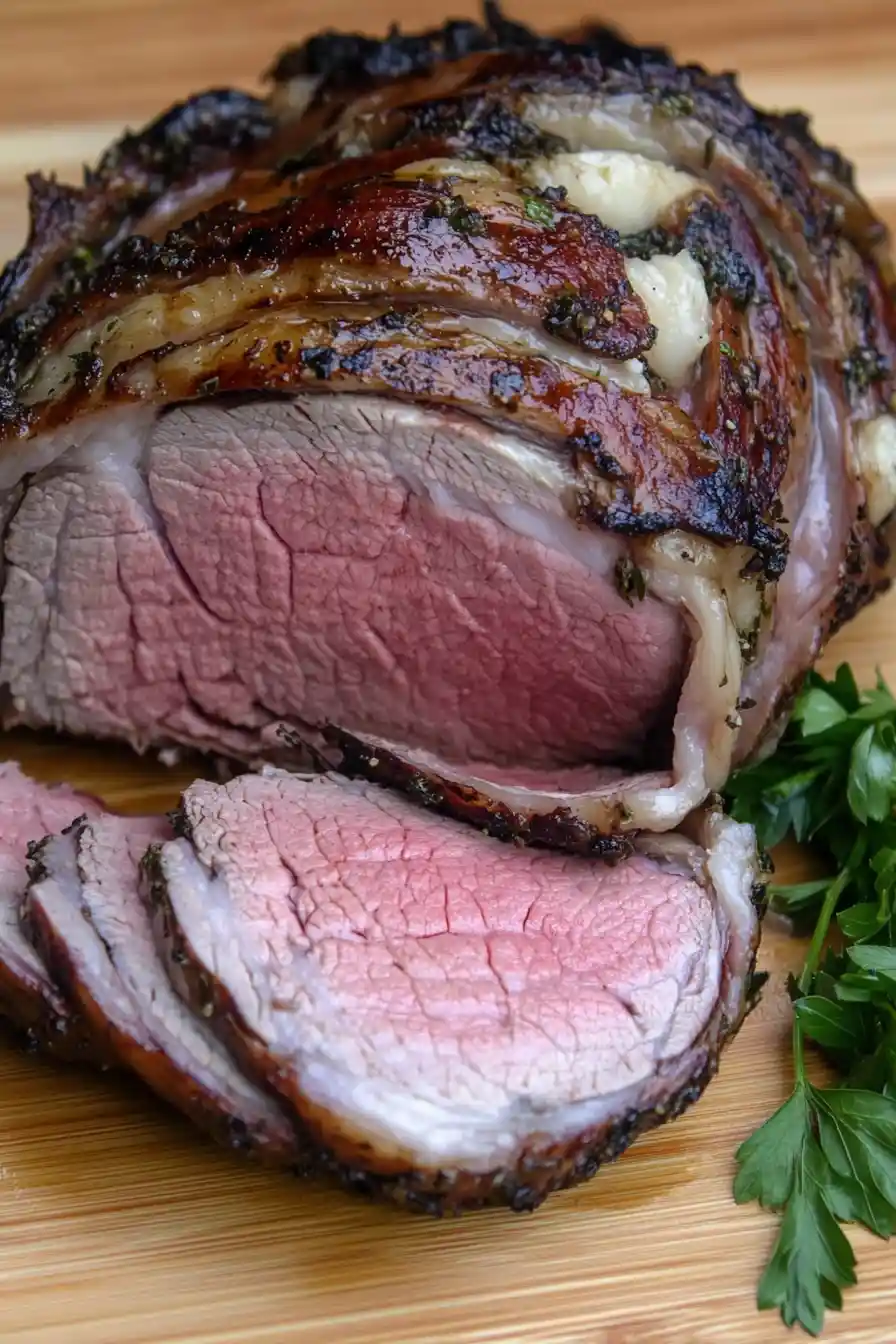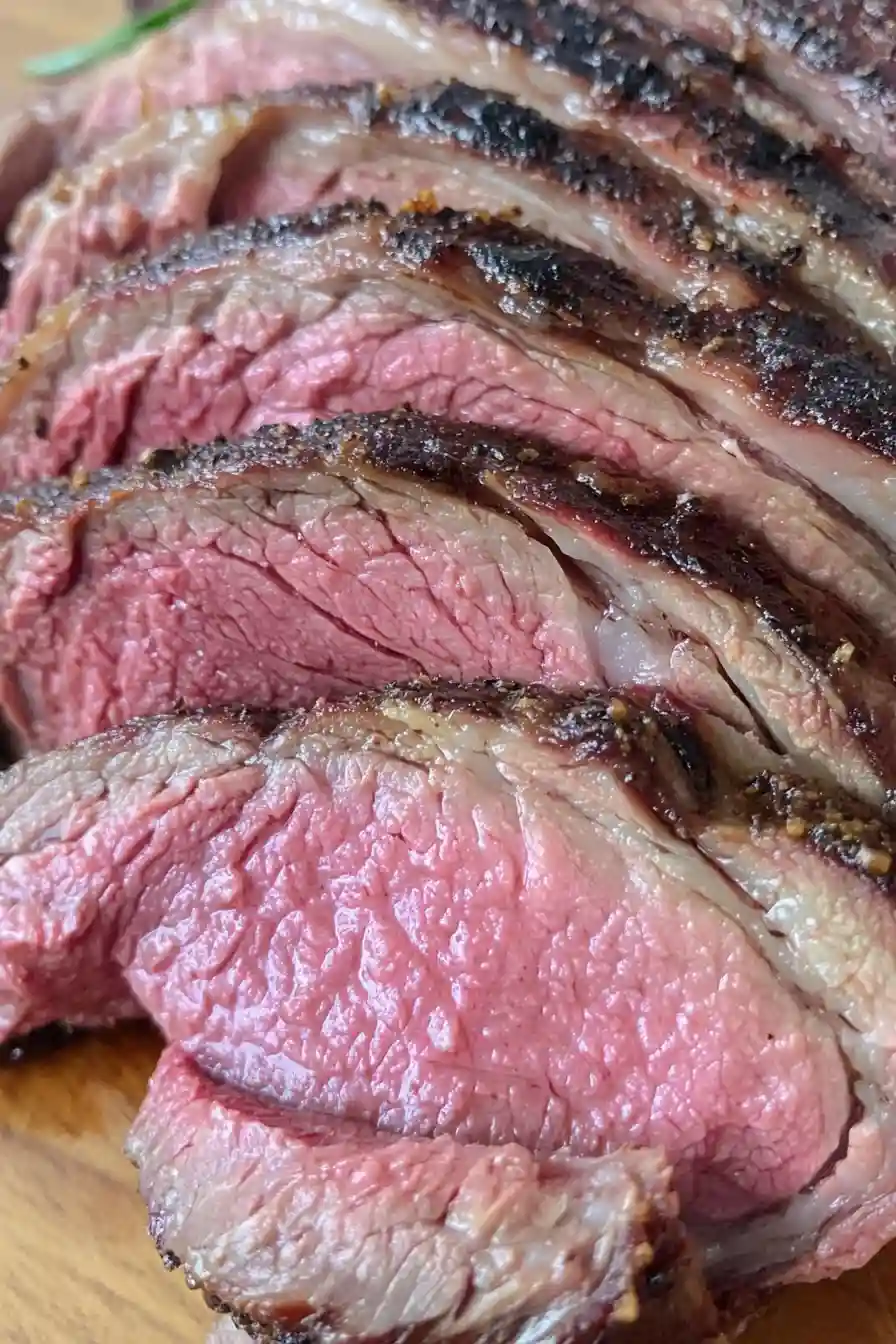I was pretty nervous the first time I tried cooking lamb. Growing up, it wasn’t something we ate at home – my mom stuck to the basics like chicken and pot roast. When I’d see lamb on restaurant menus, it seemed like this fancy, complicated meat that only professional chefs could handle.
But here’s the thing about cooking lamb sous vide – it’s actually easier than roasting a chicken. The temperature-controlled water bath does all the work, and it’s nearly impossible to overcook. Even if you’re new to cooking lamb, this method is as simple as sealing the meat in a bag and letting the sous vide machine do its magic.

Why You’ll Love This Lamb Roast
- Foolproof cooking method – Sous vide cooking ensures your lamb comes out perfectly cooked every single time – no more guessing or overcooking your expensive roast.
- Restaurant-quality results – The precise temperature control gives you edge-to-edge consistent doneness and incredibly tender meat that’s worthy of a special occasion.
- Hands-off preparation – While it takes several hours to cook, you don’t need to watch it – just set it and forget it until it’s time to sear.
- Simple ingredients – The recipe uses basic herbs and seasonings you likely already have in your pantry, letting the natural flavor of the lamb shine through.
- Make-ahead friendly – You can cook the lamb ahead of time and keep it in the water bath until ready to serve, making it perfect for stress-free entertaining.
What Kind of Lamb Should I Use?
For this sous vide recipe, you’ll want to start with a boneless leg of lamb, which you can find at most well-stocked grocery stores or butcher shops. Australian and New Zealand lamb tend to be a bit smaller and have a milder flavor, while American lamb is typically larger and has a slightly stronger, more robust taste – both work great in this recipe. If you’re buying from a butcher, ask them to remove the bone and tie the roast for you, though most grocery stores sell them already prepared this way. Just make sure your lamb has a decent amount of marbling (those little streaks of fat throughout the meat) as this will help keep the meat moist and flavorful during the long cooking process.

Options for Substitutions
This sous vide lamb recipe is pretty adaptable with several ingredient swaps you can try:
- Boneless lamb leg: While lamb leg is ideal for this recipe, you can use lamb shoulder or even a good quality lamb sirloin. Just keep in mind that cooking times might need slight adjustments based on the cut’s thickness.
- Fresh rosemary: Fresh herbs are great, but dried rosemary works well too – just use 1/3 of the amount called for. You can also experiment with thyme or oregano for a different flavor profile.
- Dijon mustard: Regular yellow mustard or whole grain mustard can work in place of Dijon. If you’re not a fan of mustard, you can skip it entirely and add an extra tablespoon of olive oil.
- Mayonnaise: The mayo helps create a nice crust when searing. You can substitute with olive oil or butter, though mayo does give the best results for that final sear.
- Garlic: Fresh and powdered garlic are interchangeable here – use what you have. If using fresh, pre-sautéing helps mellow the flavor, but you can skip this step if you’re short on time.
Watch Out for These Mistakes While Cooking
The biggest mistake when cooking sous vide lamb is not properly sealing your bag – air pockets can cause uneven cooking and floating bags, so use the water displacement method or a vacuum sealer to remove all air before submerging. Getting the temperature right is crucial – setting it too high (above 135°F for medium-rare) can lead to a tougher, less juicy roast, while too low might not give you the texture you’re looking for. Don’t skip the final searing step – it’s essential for developing a flavorful crust, but avoid searing for more than 60 seconds per side or you’ll lose the perfect doneness you achieved through sous vide. For the best flavor development, season your lamb generously before cooking and consider letting it rest in the refrigerator with the herbs and seasonings for 4-8 hours before starting the sous vide process.

What to Serve With Lamb Roast?
A tender lamb roast calls for some classic Mediterranean-inspired sides that complement its rich, savory flavors. Roasted potatoes seasoned with herbs like rosemary and thyme are a natural choice, while steamed green beans or roasted Brussels sprouts add a fresh element to the plate. For a complete meal, try serving the lamb with a mint sauce or red wine reduction, and add a Greek-style salad with cucumber, tomatoes, and feta on the side. If you want to keep things simple but delicious, some crusty bread and butter will help soak up all those wonderful juices from the meat.
Storage Instructions
Keep Fresh: After cooking your sous vide lamb roast, you can keep any leftovers in an airtight container in the fridge for up to 4 days. The vacuum-sealed bag method is great for this – just slice what you need and reseal the rest to maintain that perfect doneness level.
Freeze: If you want to save some for later, slice the cooled lamb and place it in freezer-safe bags with as much air removed as possible. It’ll keep well for up to 3 months. Pro tip: freeze individual portions so you can thaw just what you need!
Reheat: To keep that perfect sous vide texture, reheat the lamb gently. The best method is to pop it back in the sous vide at 130°F for about 30 minutes. If you’re in a hurry, warm it in a pan with a bit of butter over medium-low heat, just until heated through – this helps preserve that beautiful medium-rare color.
| Preparation Time | 30-45 minutes |
| Cooking Time | 330-480 minutes |
| Total Time | 360-525 minutes |
| Level of Difficulty | Medium |
Estimated Nutrition
Estimated nutrition for the whole recipe (without optional ingredients):
- Calories: 2200-2500
- Protein: 180-200 g
- Fat: 140-160 g
- Carbohydrates: 5-10 g
Ingredients
For the lamb and seasoning paste:
- 2 tbsp fresh chopped rosemary
- 4.5 lb boneless lamb leg
- 1 tbsp olive oil (I use California Olive Ranch extra virgin)
- 1 tbsp minced garlic
- 1 tsp dijon mustard (I like Grey Poupon)
- 1 sprig rosemary
- black pepper (freshly ground, for best flavor)
- kosher salt
- garlic powder
For finishing the lamb:
- 1 tsp dijon mustard
- pepper
- 2 tsp mayonnaise (I prefer Hellmann’s)
- salt
Step 1: Set Up Sous Vide Water Bath
Begin by setting up a water bath with an immersion circulator and heat it to your preferred temperature for lamb.
For medium rare, set it to 134°F (56°C).
Refer to Note 2 for other temperature preferences if needed.
Step 2: Make the Seasoning Paste
In a small bowl, mix together freshly chopped rosemary, Dijon mustard, minced garlic, and olive oil to create a thick seasoning paste.
This will add an aromatic and flavorful layer to your lamb.
Step 3: Prepare the Leg of Lamb
Remove the boneless leg of lamb from its packaging and, if it has a netting, slip it off.
Unroll the lamb to lay it flat, cutting any necessary slits to even out the thickness.
Using your hands, spread the seasoning paste evenly over the entire inside surface of the lamb.
Tuck in both sides at the longer ends of the lamb, then roll it into a cylinder shape.
Try to maintain the shape as evenly as possible and slip four pieces of twine underneath.
Tie knots at both ends and in the middle to secure the roll.
Ensure the roll fits into a resealable bag like a Ziploc.
Step 4: Sous Vide the Lamb
Place the rolled lamb into a resealable bag for the water displacement method.
Lower the bag into the heated water bath until the top of the bag is just above the water line to push out the air, then seal the bag.
It should sink to the bottom if sealed correctly.
Use a clip to keep it submerged if necessary.
Sous vide the lamb for 5 1/2 to 6 hours, extending to 7-8 hours if the roll is thicker than 5 inches (13+ cm).
See Note 4 for vacuum sealing information.
Step 5: Finish and Brown the Lamb
After sous vide cooking, remove the lamb from the bag and pat it dry thoroughly with paper towels to promote better browning.
Heat a grill to high heat.
In a small bowl, mix together mayonnaise (or oil) and Dijon mustard, brushing the mixture over the entire surface of the lamb.
Sear the lamb on the grill for a total of 4 minutes, turning to brown all sides.
Avoid over-charring as lamb is fatty and can cause flare-ups.
Refer to Note 5 for alternative browning options.
Step 6: Serve
Transfer the browned lamb to a cutting board.
Slice the lamb and serve with your choice of gravy (see Note 6) or other condiments.
Enjoy this succulent and tender preparation of leg of lamb with its rich flavors and perfect doneness.

